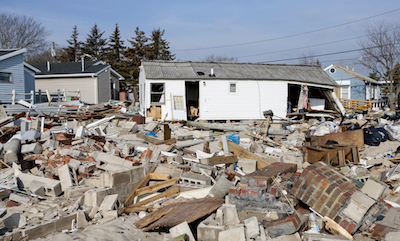After Natural Disaster, Economic Help Reduces PTSD.
 Populations feel the effects of large-scale natural disasters long after the immediate aftermath. Rates of post-traumatic stress disorder (PTSD) after a disaster can be as high as 40 percent, and, while the symptoms fade with time for most people, nearly a quarter of cases can be chronic and severe. Previous research has shown that lower-income people and people who are economically harmed by a disaster, such as by losing their home, are most likely to develop PTSD.
Populations feel the effects of large-scale natural disasters long after the immediate aftermath. Rates of post-traumatic stress disorder (PTSD) after a disaster can be as high as 40 percent, and, while the symptoms fade with time for most people, nearly a quarter of cases can be chronic and severe. Previous research has shown that lower-income people and people who are economically harmed by a disaster, such as by losing their home, are most likely to develop PTSD.
But helping individuals restore economic resources and housing after a natural disaster would significantly reduce the mental health burden in the population, according to a new simulation study led by School of Public Health researchers.
The study, published in The Lancet Planetary Health, tested a social services case management approach to disaster relief, where caseworkers at shelters would provide expedited access to personal loans and mental health services. The researchers saw a nearly two- to six-fold reduction in PTSD cases one year after the disaster.
“Meeting the social services needs of people exposed to a natural disaster would significantly benefit their mental health in post-disaster contexts,” says lead study author Gregory Cohen, statistical analyst in epidemiology. “Policy makers could likely improve post-disaster systems of mental health care by focusing on a broader set of contextual treatment targets, and leveraging a range of service providers and funding sources, such as block grants.”
Cohen and his colleagues previously found that stepped care (where people are triaged to receive the most appropriate level of mental health care) is more effective than usual care in reducing the prevalence of PTSD after a large-scale disaster. What if caseworkers in shelters could also evaluate the economic needs of those who were displaced and lost income, and provide expedited access to non-FEMA based, personal relief loans of up to $10,000?
To test this case management approach, and compare it with others, Cohen and his colleagues created a computer model of a population after a large-scale natural disaster. They based their model on data from Hurricane Sandy, which made landfall in New York City in 2012 and displaced 6,800 people, and pulled in additional data from other disasters, including 9/11 and Hurricane Katrina.
They ran the model four different ways: once where people only received the usual mental health care that they do in real life, once with the usual mental health care but with the addition of SSCM, once with stepped care, and once with both stepped care and SSCM. They ran each version of the model over a period representing two years.
For the full population in the model, the researchers found that the prevalence and persistence of PTSD were lowest under stepped care combined with SSCM, followed by stepped care without SSCM, then usual care with SSCM, and finally the greatest the prevalence and persistence of PTSD under usual care without SSCM. Looking only at the individuals who were displaced and lost income, the effectiveness of the stepped care-only and SSCM-only systems actually became more similar over time, with the prevalence and persistence of PTSD in each system winding up at the same point at the end of the two-year period.
Overall, the researchers found that a system with SSCM and usual care led to between 1.56 times as many remitted PTSD cases at the end of the first year, and 1.16 times as many remitted cases at the end of the second year. With SSCM in combination with stepped care, they saw 5.73 times as many remitted PTSD cases at the end of the first year, and between and 2.28 times as many remitted cases at the end of the second year.
PTSD treatment is expensive in the United States, costing $2,500 to $4,000 per person per year. Although the model did not specifically compare these costs to the costs of implementing the SSCM system, Cohen says, “the treatment effectiveness we observed in this simulation suggests that it would offset any additional costs of SSCM.”
The study was co-authored by Shailesh Tamrakar, research programmer in epidemiology; Laura Sampson, statistical analyst in epidemiology; Catherine Ettman, director of strategic development in the Office of the Dean; Benjamin Linas, associate professor of epidemiology; and Dean Sandro Galea. The other co-authors were: Sarah Lowe of Montclair State University; and Dean Kilpatrick and Kenneth Ruggiero of the Medical University of South Carolina.